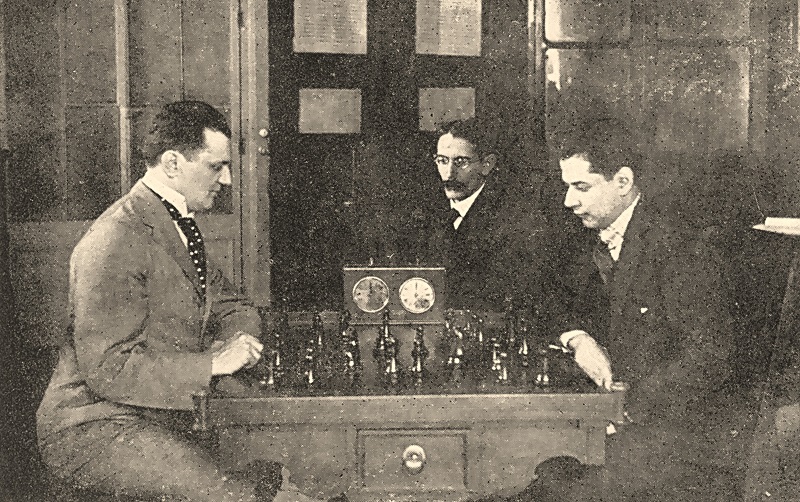
Edward Winter

B. Kostić v J.R. Capablanca, Havana, 1919 (Homenaje a Capablanca)

Rochester Democrat and Chronicle, 14 June 1915, page 14
From a blindfold simultaneous display:
Boris Kostić – D. Donaldson
Colorado Springs, July 1915
King’s Gambit Accepted
1 e4 e5 2 f4 exf4 3 Nf3 Bc5 4 d4 Bb6 5 Bxf4 Nf6 6 Nc3 O-O 7 e5 Nh5 8 Bg5 Qe8 9 g4 f6 10 Bc4+ Kh8 11 gxh5 fxg5 12 h6 g6 13 h4 g4 14 Ng5 d6 15 e6 Qc6 16 Bd5 Qe8 17 Qxg4 Qe7 18 O-O-O c6 19 h5 Rf5 20 hxg6 Rxg5 21 g7+ Kg8
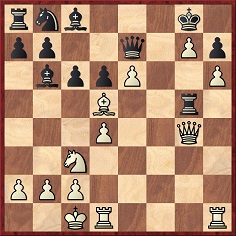
22 Ne4 Rxg4 23 Nf6+ Qxf6 24 e7+ Be6 25 e8(Q)+ and mate next move.
Sources: American Chess Bulletin, September-October 1915, page 195 and The Times Literary Supplement, 26 August 1915, page 288.
The Bulletin commented: ‘One will have to look through Morphy’s collection of games to find anything like this remarkable effort on the part of Boris Kostić.’
(BCM, 1975)
An almost identical note appeared when the game was, to our knowledge, published for the first time, on page 11 of the third section of The Sun (New York), 1 August 1915:

From Hypermodern Chess:
C.N. 815 (see page 187 of Chess Explorations) reported that in the 1920s there was discussion of how much newness there was in the ‘Hypermodern Revolution’ and whether much of it was skilful propaganda, and we commented that the earliest article known to us which expressed doubts about the ‘Revolution’ was by Carlo Salvioli in L’Italia Scacchistica, February 1926, pages 25-29. A French translation was published on pages 49-53 of the March 1926 La Stratégie. In support of his case the writer quoted Boris Kostić in Kagans Neueste Schachnachrichten, October 1925, page 441: ‘In my opinion the term “hypermodern game” is nothing but an empty word devoid of sense.’
The title of C.N. 3008 was ‘Anticipating Nimzowitsch?’, and the question mark has its purpose. For instance, Nimzowitsch had expounded certain ideas several years before the Capablanca v Wolfson game was played. See Nimzowitsch’s My System and, above all, the outstanding book Aron Nimzowitsch On the Road to Chess Mastery, 1886-1924 by Per Skjoldager and Jørn Erik Nielsen (Jefferson, 2012).
Regarding the Capablanca game and a subsequent draw by Wolfson against Boris Kostić, see Max Wolfson: Unwitting Pioneer by Olimpiu G. Urcan, an article published at the Chess Café in April 2010. Mr Urcan produced a follow-up article on Wolfson, ‘Unwitting Pioneer’, on 7 June 2018.
Wanted: information about the simultaneous blindfold game below, published on page 226 of the May 1920 Chess Amateur courtesy of the Morning Post:
Boris Kostić – N.N.
Hastings (date?)
Queen’s Gambit Declined
1 d4 d5 2 c4 e6 3 Nc3 Nf6 4 Bg5 Be7 5 e3 a6 6 Nf3 Nc6 7 Rc1 O-O 8 Bd3 Nh5 9 h4 f6
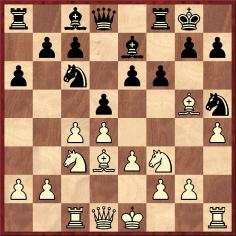
10 Ne5 fxe5 11 Qxh5 e4 12 Nxe4 dxe4 13 Bxe4 g6 14 Bxg6 hxg6 15 Qxg6+ Kh8 16 Rh3 Bf6 17 Rg3 Bxg5 18 hxg5 e5 19 Ke2 Resigns.
The Chess Amateur made no comment on 19 Ke2 or on Black’s decision to resign.
(8617)
See Blindfold Chess.
The conclusion of an article on pages 491-492 of the December 1925 BCM:
‘Kostić can claim that he is the first chess master to make a tour of the chess world in a really comprehensive way ...’
Any dissenters?
(1042)
Page 91 of Arpad Elo’s The Rating of Chessplayers, Past and Present (London, 1978) mentions a 14-game Capablanca-Kostić match (1915). No such match was ever played, and it would seem that Elo was misled by the false information in Dr P. Feenstra Kuiper’s Hundert Jahre Schachzweikämpfe (pages 76 and 84). If Elo’s historical data are largely based on Feenstra Kuiper many of his oft-quoted retrogradings will be way out.
(1302)
See Chess Ratings.
From William Winter’s posthumous reminiscences on Kostić (CHESS, 1 January 1963, page 76):
‘ ... I would ask him for the score, say, of Rubinstein v Důras, Pistyan, 1912. A few moments’ concentration and out would come the moves accompanied by short expositions on the difficult points whilst I followed it on my pocket board. He was hardly ever at fault. Naturally this colossal memory served him in good stead in his practice, but occasionally it proved a drawback, as when he spent so long trying to recall what Blackburne played in a rook ending that he lost on the time-limit.’
(1164)
On page 194 of My Chess Career (London, 1920) – although the page number varies in some later editions – Capablanca referred to Kostić’s ‘extraordinary memory’, adding: ‘he knows by heart every game played by a master in the last 20 years, and a considerable number of games of much older date.’
A modified version of the Cuban’s claim was commented upon by C.J.S. Purdy on page 66 of the April 1960 Chess World:
‘He is said to know by heart “every master game played in the last century”. Capablanca published this about Boris Kostić, but when, as a schoolboy, I asked Kostić if it were true he replied that it was absolute nonsense – that Capablanca had wildly exaggerated in order to enhance the value of his easy victory over Kostić in a match.’
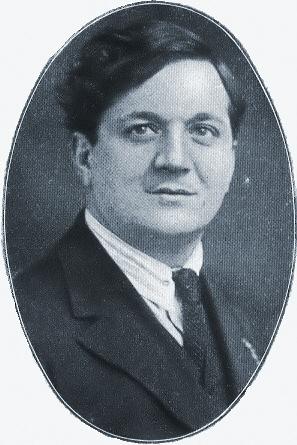
Boris Kostić
(6331)
We note now that Purdy wrote similarly about the claim on page 293 of the Australasian Chess Review, November 1936:
‘Naturally, many people swallowed this, but Kostić told the present writer that it was a wild exaggeration ventured upon by Capablanca for effect.’
(10934)
See Memory Feats of Chess Masters.
An endnote on page 262 of Chess Explorations:
Another side to Kostić arises from Heidenfeld’s reference, quoted in C.N. 4, to ‘the usual blarney Kostić used to dish out everywhere to endear himself to his varying audiences’.
The remark is on page 17 of Wolfgang Heidenfeld’s book Lacking the Master Touch (Cape Town, 1970).
(1164)
A possible example of the ‘blarney’ is gleaned from page 6 of the Western Morning News, 6 March 1922:
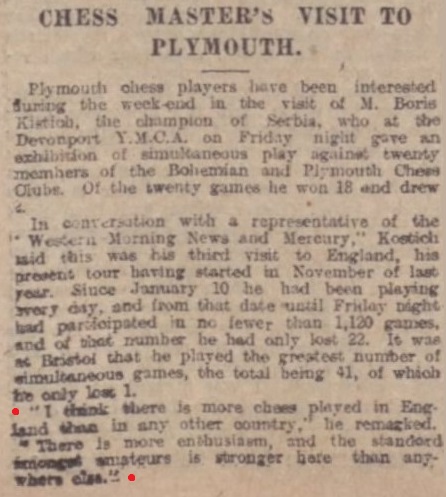
When the game is flattery, anyone may say anything anyhow about anywhere.
From an article entitled ‘Memories of Boris Kostić’ by C.J.S. Purdy on pages 23-25 of the February 1964 Chess World:
‘I cannot picture him as 76. Like all Australians and New Zealanders who remember him from 1924, I can only picture him in his late 30s – handsome though plump, expansive and genial, highly voluble and able to dish out wise truths or flagrant lies at will in eight different languages. He exuded self-esteem, but his vanity was so naïve that no-one disliked him for it. He was always so entertaining that his foibles were forgiven.’
(2741)
A position given on page 138 of A Chess Omnibus, page 138 (see also The Knight Challenge):
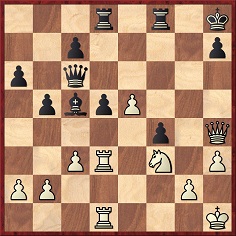
H. Fahrni-B. Kostić, Carlsbad, 12 September 1911
Black played 34…Qe6 and resigned after 35 Qxh7+ Kxh7 36 Ng5+ Kg6 37 Nxe6. His remaining three pieces are forked.
Regarding Chess Strategy and Tactics, a footnote on page 342 of A Chess Omnibus mentioned that on page 137 of the July 1955 Chess World C.J.S. Purdy wrote, ‘Kostić once said chess was 90% tactics, and he was right – not necessarily in the precise figure but in the general idea it conveys.’
We are grateful to Božidar Kažić (Belgrade, Yugoslavia) for a copy of the new edition of Ambasador šaha by Dušan Bućan (Novi Sad, 1987), a study of Kostić’s life. The original edition, in which P. Trifunović and A. Božić were also credited with authorship, was published in Belgrade in 1966. The games have been removed, but there is an increase in the amount of biographical information.
(1708)
John Finan Barry – Boris Kostić (simultaneous)
Boston, 1915
Ruy López
1 e4 e5 2 Nf3 Nc6 3 Bb5 Nf6 4 d4 exd4 5 O-O d6 6 Re1 Be7 7 Nxd4 Bd7 8 Nc3 O-O 9 Nde2 Re8 10 Ng3 a6 11 Bc4 Ne5 12 Bb3 Bf8 13 f4 Ng6 14 f5 Ne5 15 Nh5 Nxh5 16 Qxh5 c6 17 Bg5 Qc7 18 Re3 d5 19 Rh3 h6 20 Rf1 d4 21 Ne2 c5 22 Rg3 Kh8 23 Bxf7 Bb5
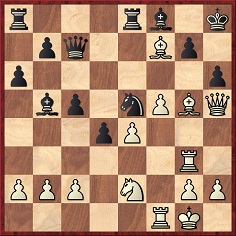
24 Bxh6 gxh6 25 Rg8+ Kh7 26 Qg6+ Nxg6 27 fxg6 mate.
Source: American Chess Bulletin, November 1915, page 212.
(1755)
Carl-Eric Erlandsson draws attention to the following report on page 58 of the 3-4/1913 issue of Tidskrift för Schack:
‘In the New Year, the chess societies of Christiania, Copenhagen, Helsinki and Stockholm were visited by the young, sympathetic Hungarian [sic] master Kostić. In Copenhagen he played two serious games with the Danish master Möller, both of which he won, and in Stockholm he defeated in a match the champion of Stockholm, Nyholm, with a score of three wins, one loss and one draw. In view of his visit to the Stockholm Schacksällskap during Easter, a circular saw tournament with 11 participants was arranged; it took place over five days, the playing time being 6-12 p.m. Every participant had to play two games simultaneously, and the time for play was 15 moves per hour for each game. The results are shown in the following table: ...’
The magazine then gives the crosstable (see page 430 of Gaige’s Chess Tournament Crosstables). Kostić won by a margin of 2½ points. Our correspondent comments:
‘The same issue of the Swedish magazine gives 15 of the 55 games from this tournament. It would be interesting to know when such circular saw tournaments were first arranged. I think the name must have some connection with the players’ seating – possibly the 11 players sat at a round table with 11 “prongs” and with one player sitting at each inner “jag”.’
(1828)
From Jan Kalendovský (Brno, Czech Republic) comes a game played in a blitz tournament following the conclusion of the Olympiad:
Boris Kostić – Paul Keres
Stockholm, 1937
Two Knights’ Defence
1 e4 e5 2 Nf3 Nc6 3 d4 exd4 4 Bc4 Nf6 5 O-O d5 6 exd5 Nxd5 7 Ng5 Be7 8 Nxf7 Kxf7 9 Qh5+ g6 10 Bxd5+ Kg7 11 Bh6+ Kf6 12 Qg5 mate.
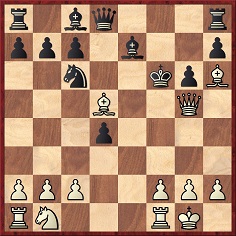
Source: Šachový tyden, 1937, page 119.
(2036)
See Fast Chess.
A game taken from pages 46-47 of part 1 of Schachjahrbuch für 1911 by L. Bachmann:
Georg Wiarda – Boris Kostić
Cologne, 15 April 1911
Four Knights’ Game
1 e4 e5 2 Nf3 Nc6 3 Nc3 Nf6 4 Bb5 Bb4 5 O-O O-O 6 d3 Nd4 7 Bc4 c6 8 Bg5 d5 9 exd5 Bg4 10 dxc6 Qc8 11 Bxf6 Bxf3 12 gxf3 Qh3 13 cxb7 Rae8 14 Bd5
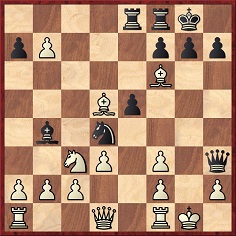
14...e4 15 b8(Q) Rxb8 16 Bxd4 Bd6 17 Re1 Bxh2+ 18 Kh1 Be5+ 19 Kg1 Bxd4 20 Rxe4 Rb6 21 Qf1 Qxf3 22 Re6 Qg4+ 23 Qg2 Qxg2+ 24 Bxg2 fxe6 25 Ne4 Rxb2 26 White resigns.
(2158)
This position arose after White’s 86th move in the game Kostić v Jaffe, Carlsbad, 4 September 1911, as published on pages 161-162 of volume 1 of the tournament book:
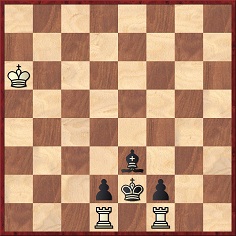
Play continued 86...Bd4 87 Kb5 Be3 88 Kc4 Bb6 89 Kc3 Be3 90 Kc2 Bg5 91 Rh1 Bf4 92 Rh4 Bg5 93 Rh5 Bf4 94 Rf5 Bh6 95 Re5+ Be3 96 Re7 Resigns.
(2159)
Not a spectacular game, but an early indication of Fairhurst’s strength:
Boris Kostić (Simultaneous) – William Albert Fairhurst
Manchester, 1922
Queen’s Gambit Declined
1 d4 d5 2 Nf3 Nf6 3 c4 e6 4 Nc3 Be7 5 Bg5 Nbd7 6 e3 O-O 7 Rc1 c6 8 Qc2 c5 9 Bd3 cxd4 10 exd4 b6 11 O-O dxc4 12 Bxc4 Bb7 13 Ne5 Nxe5 14 dxe5 Ng4 15 Rfd1 Qc7 16 Bxe7 Qxe7 17 Qe2 Qh4 18 h3 Nxf2 19 Qxf2 Qxc4 20 Nd5 Qe4 21 Ne7+ Kh8 22 Rc7 Ba6 23 Re1 Qb4 24 Nc6 Qc4 25 b3 Qc3 26 Re3 Qc1+ 27 Re1 Qc3 28 Re3 Qc1+ 29 Kh2 Bb5 30 Qf3 Bxc6 31 Rxc6 Qd2 32 Rc7 Kg8 33 Rxf7 Rxf7 34 Qxa8+ Rf8 35 Qe4 Qxa2 36 Qc6 Qf2 37 Qxe6+ Qf7 Drawn.
Source: the Chess Amateur, May 1922, pages 230-231.
(2589)
See also C.N. 8568 below.
The game below is of interest not for spectacular combinations or limpid technique but for the energy with which Kostić pursued the attack:
Oei Kang Ing and Liem Tjoe Bo – Boris Kostić
Soerabaja, 12 September 1925
Queen’s Gambit Declined
1 d4 d5 2 Nf3 Nf6 3 c4 e6 4 Bg5 h6 5 Bh4 Bb4+ 6 Nc3 c5 7 e3 Qa5 8 Qb3 Ne4 9 Rc1 b5 10 cxd5 c4 11 Qc2 exd5 12 Nd2 Bf5 13 Ndxe4 Bxe4 14 Qd2 Nc6 15 f3 Bg6 16 Be2 O-O 17 a3 Bxc3 18 Qxc3 b4 19 axb4 Qxb4 20 Bg3 Rfe8 21 Kf2 Qb6 22 Ra1
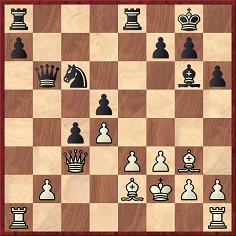
22…Re6 23 Ra3 Rae8 24 Qd2 Nxd4 25 Bd1 Nb5 26 Ba4 d4 27 e4 c3 28 Qd3 Nxa3 29 bxa3 Qb2+ 30 Bc2 f5 31 Qd1 fxe4 32 Kg1 exf3 33 White resigns.
Source: Jubileum Uitgave van de Soerabajasche Schaakclub by W.N. Dinger (Soerabaja, 1936), pages 159-164.
(2649)
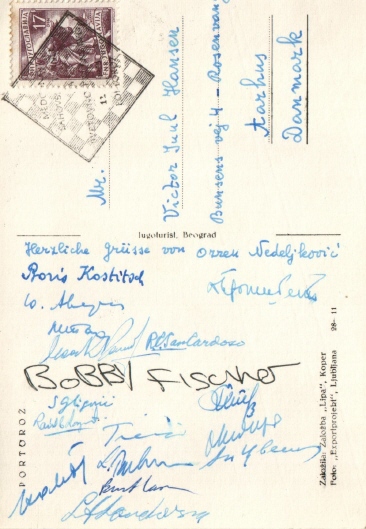
We are grateful to Charles Milton Ling (Vienna), Hassan Roger Sadeghi (Lausanne, Switzerland) and Dan Scoones (Victoria, BC, Canada) for identifying various signatures, in addition to those mentioned in C.N. 4319 (which were Cardoso, Fischer, Gligorić, Kostić, Larsen and Pachman). The collective result of our three correspondents’ submissions is the following:
Averbakh (below Kostić) and Tal (below Averbakh). To the right of Kostić: Bronstein. Below Gligorić: Sanguineti. Below the word ‘Fischer’: Petrosian.
(4334)
The practice of passing in simultaneous exhibitions was discussed on page 232 of the April 1964 CHESS. A reader, H.H. Watts of Southport, wrote:
‘Just prior to the First World War I played against Kostić in Manchester. After about 12 moves he obviously did not like his position because, from then on, after I had made my move he would look at it and pass on without moving but made his move at once on his next round. Consequently only about 25 moves were made, and he announced that it was a draw, as not enough had been done.
Boris Kostić
Then just prior to the Second World War I had the other experience against Alekhine in Liverpool. I was one of the last three still playing, with a pawn up and, as he told me afterwards, a winning position. He ran round these remaining three, insisting on a move each time he appeared, and I duly blundered and lost.’
In the mid-June 1964 issue of CHESS (page 306) C.W. Warburton of Warrington wrote:
‘... in the same situation against Sir G. Thomas in 1936 I reacted rather differently. I indicated that I was not ready and he could pass on, but he would not and stood fidgeting until I was ready to move, for I had determined I would not be rushed. After all I had attended to play a game of chess not skittles. In contrast, Capablanca was always prepared to move on to the next board if a player were not ready.’
(4958)
Dan Scoones (Coquitlam, BC, Canada) sends the following extract from a report on page 19 of the New York Times, 20 July 1919:
‘By invitation of the I.L. Rice Progressive Chess Club, Metropolitan League champions, Oscar Chajes, Charles Jaffe and Boris Kostić started a short three-cornered tournament at that club yesterday. The pairings brought together Jaffe and Kostić in the first round, Kostić winning the toss for move and selecting the Ruy López. The Serbian brought about an early exchange of queens, Jaffe being left in possession of two bishops. The latter won a pawn at his 24th turn, and playing in excellent style thereafter, brought about Kostić’s resignation after 48 moves had been recorded. Jaffe will play against Chajes in the next round.’
Our correspondent asks what more is known about this event and whether any games have survived.
He also points out that databases contain a lively game allegedly played by Jaffe and Kostić in New York in 1919 but which does not match the above description: 1 e4 e5 2 Nf3 Nc6 3 Bc4 Nf6 4 Ng5 d5 5 exd5 Na5 6 Bb5+ c6 7 dxc6 bxc6 8 Bd3 Bd6 9 c3 h6 10 Ne4 Nxe4 11 Bxe4 O-O 12 d4 f5 13 dxe5 fxe4 14 Qxd6 Qh4 15 Be3 Ba6 16 Nd2 Rad8 17 Qb4
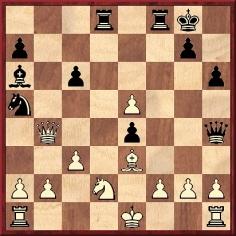
17...Rxd2 18 Kxd2 Rxf2+ 19 Kc1 Rxg2 20 Qxa5 Bc8 21 Rd1 Qh3 22 Qd8+ Kh7 23 Qd4 Qf3 24 Re1 c5 25 Qd5 Rxh2 26 Bd2 Bf5 27 e6
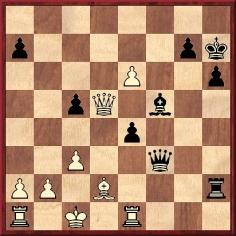
27...e3 28 Qxf3 exd2+ 29 Kd1 Bc2+ 30 Kxc2 dxe1(Q)+ 31 Kb3 Qxe6+ 32 c4 Qb6+ 33 Kc3 Qxb2+ 34 Kd3 Qd4 mate.
Information on this game is sought.
(5263)
Rapid progress on this matter can be reported, thanks to Eduardo Bauzá Mercére (New York, NY, USA). He points out, firstly, that on pages 141-142 of Ambasador Šaha by D. Bućan, P. Trifunović and A. Božić (Belgrade, 1966) there are two games between Kostić and Jaffe in New York in 1919, i.e. the one given in C.N. 5263 and the following:
Boris Kostić – Charles Jaffe1 e4 e5 2 Nf3 Nc6 3 d4 exd4 4 Bc4 Qf6 5 c3 d3 6 O-O d6 7 Qxd3 Bg4 8 Bg5 Qg6 9 Nbd2 Be7 10 Qe3 h6 11 Bh4 Bxh4 12 Nxh4 Qh5 13 g3 Bh3 14 Rfe1 Nge7 15 Be2 Bg4 16 f3 Bd7 17 f4 Bg4 18 Nhf3 O-O-O 19 b4 g5 20 f5 Kb8 21 a4 f6 22 b5 Ne5 23 a5 d5 24 b6 dxe4 25 Nxe5 Bxe2 26 Rxe2 fxe5 27 bxa7+ Ka8 28 a6 b6 29 Qxe4+ c6 30 Nc4 Kxa7 31 Qxe5 Rd7
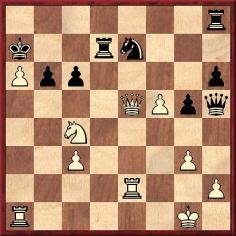
32 Qxe7 Rhd8 33 Qxd8 Resigns.
Our correspondent also provides three articles by Hermann Helms in his Brooklyn Daily Eagle column.
‘Kostić Seeking Passports
For the first time since he lost his match with Capablanca at Havana, Boris Kostić, the Serbian champion, put in an appearance in this city yesterday, visiting both the Manhattan Chess Club and the I.L. Rice Progressive Chess Club, where friends greeted him and tendered their condolences. Kostić in the interim has been at his home in Gary, Ind., where, like many another notable, he has been putting in a part of his time chopping down trees on his father-in-law’s farm. Although this exercise at the start yielded a fine crop of blisters, it was, nevertheless, fine training for the chess master, who is planning to go abroad to take part in the Victory Tournament of the British Chess Federation at Hastings, 11-23 August.
Kostić looked a bit thinner than when he was here last, but he says he lost 18 pounds while in Havana, nor was he sorry to lose it. He is down to fighting weight, so to speak, and, with an ocean voyage thrown in, he will be fit to do himself full justice when the Mayor [of] Hastings officially declares the international masters’ tournament under way.
The purpose of Kostić’s visit is to obtain the necessary passports to enable him to get across ...’
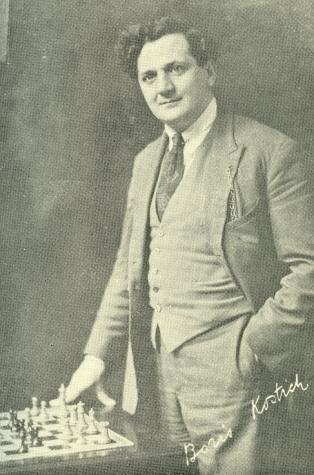
Boris Kostić
‘Kostić in training
‘Boris Kostić, preparatory to his departure for England next Saturday, is making the most of his brief stay in New York by getting as much practice as possible at the rooms of the I.L. Rice Progressive Chess Club, twice winner of the Metropolitan League championship. His chief opponent has been Charles Jaffe, with whom he has contested a number of games for purses provided by the members and has been successful in the majority. Two specimens of their play are appended, together with one wrested from Jaffe in a similar game by Oscar Chajes.’
Below are the three games:
Boris Kostić – Charles Jaffe
New York, July 1919
Ruy López
1 e4 e5 2 Nf3 Nc6 3 Bb5 a6 4 Bxc6 dxc6 5 d4 exd4 6 Qxd4 Bg4 7 Be3 Qxd4 8 Nxd4 c5 9 Ne2 O–O-O 10 Nd2 f6 11 f3 Be6 12 O-O-O b6 13 Nf4 Bf7 14 Nb3 Bd6 15 Nd5 Ne7 16 c4 Ng6 17 g3 Ne5 18 Nd2 Rhe8 19 Kc2 Kb7 20 b3 Nc6 21 a3 Nd4+ 22 Kb2 Be5 23 f4 Bd6 24 Nc3 Bh5 25 Rde1 Nf3 26 Ref1 Nxd2 27 Bxd2 Bf8 28 Kc2 c6 29 h3 b5 30 g4 Bf7 31 cxb5 axb5 32 Rf2 b4 33 axb4 cxb4 34 Na4 Rxe4 35 Re1 Rxe1 36 Bxe1 c5 37 Rd2 Rxd2+ 38 Bxd2 Kc6 39 Nb2 Kb5 40 Be3 c4 41 Bd4 Bd5 42 bxc4+ Bxc4 43 g5 Bc5 44 Bxc5 Kxc5 45 gxf6 gxf6 46 Na4+ Kd4 47 Nb6 Be6 48 White resigns. (This was the game described by the New York Times report on 20 July 1919, as quoted in C.N. 5263.)
Charles Jaffe – Boris Kostić
New York, July 1919
King’s Gambit Accepted
1 e4 e5 2 f4 exf4 3 Bc4 Nf6 4 Nc3 Bb4 5 Qf3 Nc6 6 Qxf4 O-O 7 Nf3 Bxc3 8 dxc3 d5 9 exd5 Re8+ 10 Be3 Na5 11 White resigns.
Charles Jaffe – Oscar Chajes
New York, July 1919
Philidor’s Defence
1 d4 Nf6 2 Nf3 d6 3 e4 e5 [Sic. The move order given by the newspaper.] 4 Nc3 Nbd7 5 Bc4 Be7 6 Ng5 O-O 7 f4 exf4 8 Bxf4 d5 9 exd5 Nb6 10 Qd3 Nxc4 11 Qxc4 Ne8 12 Nge4 a6 13 a3 b5 14 Qb3 Rb8 15 Nc5 Rb6 16 N3e4 Rg6 17 O-O Nf6 18 Nxf6+ Bxf6 19 Be5 Bxe5 20 dxe5
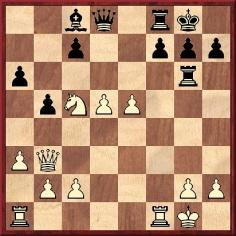
20...Qg5 21 Qf3 Qxe5 22 Rae1 Qd4+ 23 Qe3 Qxd5 24 Rf2 Bh3 25 g3 h5 26 Rd2 Qc6 27 Nd3 Re6 28 Ne5 Qb7 29 Qf2 Rf6 30 Qc5 Re8 31 Red1 Rf5 32 Qc6 Qa7+ 33 Kh1 Rfxe5 34 Rd8 Qe3 35 Rxe8+ Rxe8 36 Rg1 Bf5 37 White resigns.
‘Win missed by Kostić
Just before his departure for Europe, Boris Kostić had a prolonged sitting with Oscar Chajes at the I.L. Rice Progressive Chess Club of Manhattan, which ended in a draw after 91 moves. The three-cornered Chajes-Jaffe-Kostić series ended in favor of Chajes, 1½-½; Jaffe 1-1; Kostić ½-1½. The score of the game follows.’
Oscar Chajes – Boris Kostić
New York, July 1919
Petroff’s Defence
1 e4 e5 2 Nf3 Nf6 3 Nc3 Bb4 4 Bc4 O-O 5 O-O d6 6 d3 Be6 7 Bb3 Nc6 8 Bg5 h6 9 Bh4 Bxc3 10 bxc3 Kh8 11 d4 Bxb3 12 axb3 Qe7 13 Re1 a6 14 d5 Nb8 15 c4 Nbd7 16 b4 g5 17 Bg3
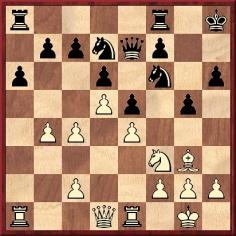
17...Nxe4 18 Rxe4 f5 19 Bxe5+ dxe5 20 Re2 Rae8 21 c5 e4 22 Nd4 Ne5 23 Ne6 Rf7 24 Ra3 Qf6 25 Rh3 Kg8 26 Rd2 Kh7 27 Kf1 c6 28 Rh5 Rg8 29 Ke1 Nc4 30 Re2 Rd7 31 Nd4 Rxd5 32 c3 Qg6 33 Rh3 g4 34 Rh4 Qg5 35 g3 Ne5 36 Qb1 Nf3+ 37 Nxf3
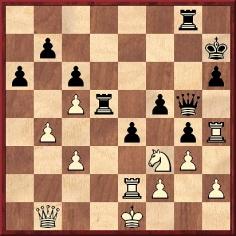
37...exf3 (‘Instead, as pointed out by Janowsky, Black might have won offhand and prettily by means of 37...gxf3 38 Rc2 Qxh4, and White dare not capture queen, on account of ...Rg1 mate.’) 38 Re3 Rgd8 39 h3 Kg7 40 hxg4 fxg4 41 c4 Rd4 42 Qa1 h5 43 Kf1 Kf6 44 Re1 Qf5 45 Kg1 Kg6 46 b5 cxb5 47 cxb5 Qxc5 48 bxa6 bxa6 49 Qxa6+ R4d6 50 Qa2 Qd5 51 Qc2+ Qd3 52 Qc5 Qd5 53 Qc2+ Kh6 54 Qc1+ Kg6 55 Qc2+ Kh6 56 Qc1+ Kh7 57 Qc2+ Kg8 58 Qc1 Qf5 59 Qc4+ Rd5 60 Re4 Rc8 61 Qa4 Rd2 62 Re1 Re2 63 Rd1 Rce8 64 Qc4+ Kh7 65 Qc3 R8e7 66 Qb4 R2e4 67 Qc3 Re2 68 Qb4 Kg6 69 Rc1 R2e4 70 Qd2 Qb5 71 Qd6+ R7e6 72 Qf8 Re8 73 Qd6+ R4e6 74 Qd2 Rc6 75 Ra1 Rce6 76 Qc2+ Kh6 77 Qc1+ Qg5 78 Qc3 Qe5 79 Qd2+ Kg6 80 Qc2+ Qe4 81 Qc5 Qe5 82 Qc2+ Kg7 83 Rd1 R8e7 84 Qc4 Rc7 85 Qa4 Rec6 86 Rh1 Rc2 87 Rh4 Rc1 88 Kh2 Rxd1 89 Qxd1 Qb2 90 Qe1 Kf8 91 Rxh5 Re7 Drawn.
Our correspondent concludes:
‘It is interesting to note the complete coverage given by Helms in the Eagle, and his total silence on the subject in the American Chess Bulletin. As regards the three-cornered masters’ tournament, with only three games played (not even a double round-robin), it must be the shortest on record.’
(5266)
This Nice, 1930 group photograph was published on page 68 of the April 1930 American Chess Bulletin:
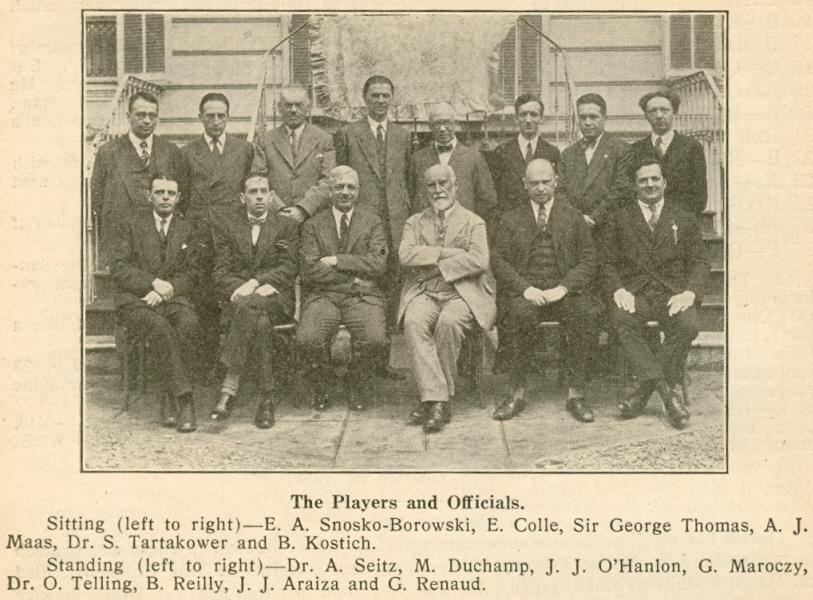
(5319)
Irving Chernev gave ‘some personal opinions’ on page 28 of the November-December 1933 Chess Review. The first was the following:
‘The perfect game is Réti-Kostić, Teplitz, 1922.’
(5624)
Wanted: solid contemporary sources for a brevity commonly ascribed to Boris Kostić: 1 e4 e5 2 Nf3 Nc6 3 Bc4 Nd4 4 Nxe5 Qg5 5 Nxf7 Qxg2 6 Rf1 Qxe4+ 7 Be2 Nf3 mate.
The occasion is generally given as Cologne, 1911 or 1912, with White’s name rendered as Muelock, Muhlock, Mulok, etc.
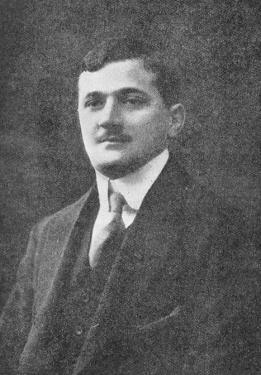
Boris Kostić
(6479)
Peter Anderberg (Harmstorf, Germany) has found the Kostić game on pages 144-145 of Deutsche Schachblätter, 15 December 1912, in a set of 15 miniatures:
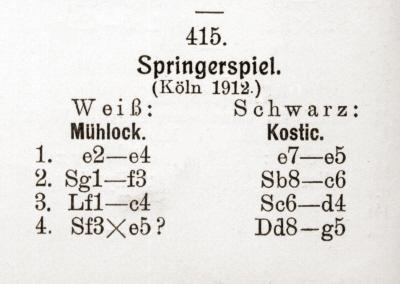
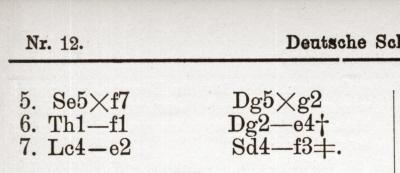
(7737)
On pages 32-33 of the 5/2004 New in Chess Boris Spassky mentioned in an interview that at one time Enrico Caruso’s entourage included Boris Kostić.
Kostić took up residence in the United States in the first half of 1915, as reported on page 108 of the May-June 1915 American Chess Bulletin. His contact with Caruso was related on pages 34-35 of Ambasador Šaha by D. Bućan, P. Trifunović and A. Božić (Belgrade, 1966) and on pages 33-35 of Ambasador Šaha by D. Bućan (Novi Sad, 1987), and we shall be grateful if a reader can assist us in extracting the hard facts from those two accounts.
Neither book gave any games played between Kostić and Caruso, but on pages 93-94 of Chess to Enjoy (New York, 1978) A. Soltis wrote:
‘One of the most aggressive players in the musical world was Enrico Caruso, who took the game seriously enough to study under Boris Kostić, the first great Yugoslav player. Here is one of their many skittles or offhand games with the mighty tenor playing Black.’
The moves, presented with the customary Soltis sourcelessness, were: 1 d4 d5 2 Nf3 Nf6 3 c4 e6 4 Nc3 Nbd7 5 Bg5 Bb4 6 e3 c5 7 Qc2 Qa5 8 Bxf6 Nxf6 9 Nd2 cxd4 10 exd4 O-O 11 a3 e5 12 dxe5 d4 13 Nb5 a6 14 exf6 Re8+ 15 Kd1 axb5 16 fxg7 Bxd2 17 Qxd2 Qa4+ 18 Kc1 bxc4 19 Be2 c3 20 Qd1 Qa5 21 Bd3 cxb2+ 22 Kxb2 Qc3+ 23 Kb1 Re6 24 Bxh7+ Kxh7 25 White resigns.
No place or date was stipulated, but when B. Pandolfini gave the conclusion on page 106 of Treasure Chess (New York, 2007) he put ‘1918’. In some databases (as well as on page 55 of CHESS, September 2004) ‘New York, 1923’ is specified – even though Caruso died in 1921.
(6951)
We add that on page 18 of the November-December 1996 issue of Chess Horizons (acknowledgement: Cleveland Public Library) Josef Vatnikov gave the game, stating, without evidence, that it was ‘played in New York in 1914’.
After just five words Vatnikov deployed ‘once’:
‘The great singer Enrico Caruso once said: “My favorite opening, playing Black, was the Philidor’s Defense.” In due time the famous Italian tenor played a lot of games with the Yugoslav grandmaster Bora Kostic, who was his chess trainer. “Caruso liked chess very much”, said Kostich, “I appreciated his chess ability. He could be on the offensive perfectly. Probably, many chess masters would envy his brilliant combinations.”’
There is no indication as to where any of this came from.
(12108)
For the forthcoming book on Indian chess history referred to in C.N. 6152 Manuel Aaron (Chennai, India) is trying to resolve a discrepancy concerning the result of the tournament held in Chail (Patiala Princely State) from 29 May to 13 June 1925. The crosstable indicates that B. Kostić finished second with ten points, half a point behind N.R. Joshi, whereas Kostić subsequently stated (East African Standard, 19 September 1925) that the two players tied for first place. The matter hinges on whether Kostić’s game against S. Kishanlal, who finished third, was a win for Kostić, as he claimed, or only a draw. Can the game-score be found?
(7528)
As reported in C.N. 2543, when asked to name the best annotator, Tartakower replied (Wiener Schachzeitung, June 1929, page 169):
‘Kostić, who always pours out his soul, which is most amusing and instructive.’
C.N. 2543 mentioned that Kostić was hardly illustrious as an annotator, but that the exact point of Tartakower’s apparent quip is unclear.
(7819)
Juan Vargas – Boris Kostić
Montevideo, 1913
Ruy López
1 e4 e5 2 Nf3 Nc6 3 Bb5 a6 4 Ba4 Nf6 5 d4 exd4 6 O-O Be7 7 e5 Ne4 8 Nxd4 Nc5
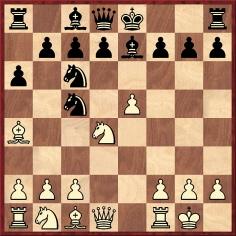
9 Nf5 h5 10 Nxg7+ Kf8 11 Nxh5 Nxe5 12 Nc3 d6 13 h3 Nxa4 14 Nxa4 Bxh3 15 Nf4 Bg4 16 f3 Bd7 17 Nc3 Bh4 18 Ne4 Bb5 19 Ne2 d5 20 N4c3 Qd6 21 Nxb5 axb5 22 Bf4 Ra4 23 Be3
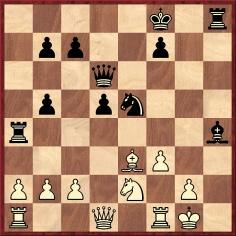
23...Ng4 24 fxg4 Qh2+ 25 Kxh2 Bf2+ ‘and mate next move’.
Source: Capablanca-Magazine, 31 December 1913, page 235.
(8149)
As reported in C.N. 11631, the game was discussed on pages 61 and 164 of The Magic of Chess Tactics 2 by Claus Dieter Meyer and Karsten Müller (Milford, 2017):
Olimpiu G. Urcan (Singapore) forwards a game published by Louis van Vliet on page 5 of the Sunday Times, 12 July 1931:
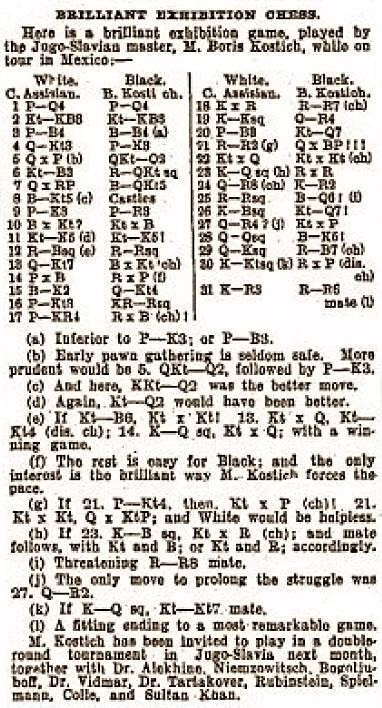
C. Assisian (?) – Boris Kostić
Mexico (exact occasion?)
Queen’s Gambit Declined
1 d4 d5 2 Nf3 Nf6 3 c4 Bf5 4 Qb3 e6 5 Qxb7 Nbd7 6 Nc3 Rb8 7 Qxa7 Bb4 8 Bg5 O-O 9 e3 h6 10 Bxf6 Nxf6 11 Ne5 Ne4 12 Rc1 Ra8 13 Qb7 Bxc3+ 14 bxc3 Rxa2 15 Be2 Qg5 16 g3 Rfa8 17 h4 Rxe2+ 18 Kxe2 Ra2+ 19 Ke1 Qh5 20 f3 Nd2 21 Rh2
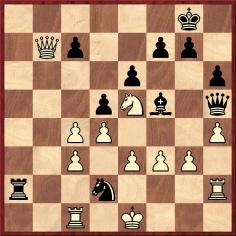
21...Qxf3 22 Nxf3 Nxf3+ 23 Kd1 Rxh2 24 Qa8+ Kh7 25 Ra1 Bd3 26 Kc1 Nd2 27 Qa4 Nxc4 28 Qd1 Be4 29 Qe1 Rc2+ 30 Kb1 Rxc3+ 31 Ka2 Ra3 mate.
When the game was published on pages 175-176 of Ambasador Šaha by D. Bućan, P. Trifunović and A. Božić (Belgrade, 1966) White’s name was given as ‘Asian’, and the heading also stated ‘Meksiko Siti, 1930’.
Page 112 of the July-August 1930 American Chess Bulletin reported that Kostić ‘is at present in Mexico City, where, we understand, he is fulfilling a six months’ engagement teaching chess to Mexican army officers’. His visit to Mexico City was also mentioned on page 149 of the September-October 1930 Bulletin. In December he travelled to St Louis in the United States for chess engagements (December 1930 issue, page 187).
(8230)
In the early 1920s the name N. Schwartz often appeared in connection with chess in Scotland. For instance, in 1922 he was one of seven participants in the Scottish championship in Perth (BCM, May 1922, pages 195-196), and other issues of the magazine (e.g. January 1922, page 22) referred to him as playing for Dundee. He was also mentioned on page 228 of the May 1922 Chess Amateur:
‘At Dundee Kostić played two consultation games, and won both, against Messrs. Heath, Thoms and Griffiths [sic – Griffith] at one board, and against Messrs. Spankie, Forbes, Schwartz, “etc.” at the other.’
The game involving Schwartz was published on page 6 of the Dundee Courier, 29 March 1922:
Boris Kostić – D. Spankie, N. Schwartz, C.S. Forbes and
others
Dundee, 28 March 1922
Queen’s Gambit Declined
1 d4 d5 2 Nf3 Nf6 3 c4 e6 4 Nc3 Nbd7 5 Bg5 Be7 6 e3 a6 7 c5 O-O 8 Bd3 Re8 9 O-O h6 10 Bh4 Nh7 11 Bg3 Ng5 12 Ne5 Nxe5 13 Bxe5 Nh7 14 Rc1 Bf6 15 Bg3 Nf8 16 f4 Bd7 17 Bf2 b6 18 b4 b5 19 a3 c6 20 Qh5 a5 21 g4 axb4 22 axb4 Ra7 23 Kh1 Re7
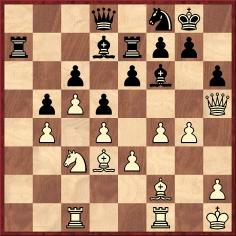
24 Rg1 Be8 25 g5 hxg5 26 fxg5 Bxd4 27 exd4 g6 28 Qh6 f5 29 gxf6 Rh7 30 Qg5 Qd7 31 Ne2 Ra3 32 Nf4 Qc7 33 Bg3 Qf7 34 Be1 e5 35 Nxg6 Nxg6 36 Bxg6 Qxg6 37 Qxe5 Qxg1+ 38 Kxg1 Resigns.

The newspaper’s chess coverage at that time had many references to ‘N. Schwartz’, and the initial ‘M.’ above would appear to be an error. Although the crosstable for the Scottish championship on page 196 of the May 1922 BCM also had ‘M. Schwartz’, the Scottish newspaper reports on the event that we have seen (e.g. the Dundee Courier, 19 April 1922, page 6) specify that the player was N. Schwartz. In no newspaper has his forename been found.
(8567)
For further information on Schwartz, see ‘The Immortal Blindfold Game’.
From page 80 of the December 1921 Chess Amateur:
‘Mr Antony Guest says:
“Mr Boris Kostić, after taking a prominent part in the tournaments at Budapest and The Hague, is now visiting London, and will probably remain here most of the winter. He is desirous of giving exhibitions of blindfold and simultaneous play on terms arranged to meet the conditions of the smaller as well as the more important clubs. Communications should be sent to him at the Hampden Club, King’s Cross, NW1.”’
A detailed list of results in the first part of Kostić’s tour was published on page 86 of the March 1922 BCM:
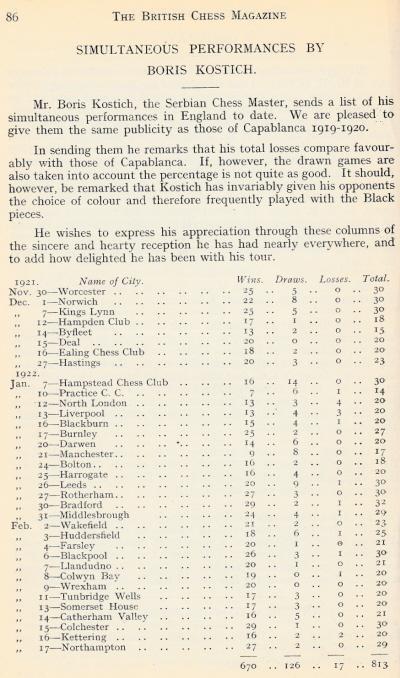
One of his simultaneous games, a draw in Manchester against the 18-year-old W.A. Fairhurst, was given on page 80 of A Chess Omnibus from pages 230-231 of the May 1922 Chess Amateur. [See C.N. 2589 above.] The exact date was not available, but a brief report from page 3 of the Manchester Guardian, 20 March 1922 can be added here:
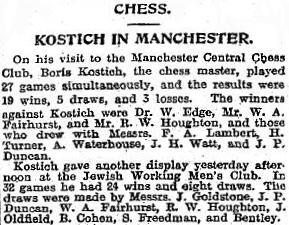
We thus tentatively propose 19 March 1922 as the date of Fairhurst’s draw.
With regard to another player mentioned in the above Manchester Guardian report, A. Waterhouse, a loss by him to Kostić in one of the displays in Manchester was published on page 314 of the July 1922 Chess Amateur:
1 d4 g6 2 e4 Bg7 3 Nf3 d5 4 e5 Bg4 5 h3 Bxf3 6 Qxf3 e6 7 Bd3 Nd7 8 O-O c5 9 c3 Rc8 10 Re1 Bh6 11 Nd2 Ne7 12 dxc5 Nxc5 13 Bb5+ Nc6
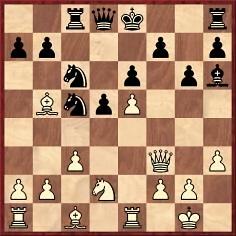
14 Nc4 dxc4 15 Bxh6 Qh4 16 Bxc6+ Rxc6 17 Bg7 Rg8 18 Bf6 Qh6 19 Rad1 Nd7 20 Qe4 Resigns.
The final move was given on page 344 of the August 1922 issue.
The Chess Amateur often had a carefree attitude to game details, and the score below was published on page 232 of the May 1922 issue with the vague heading ‘One of the six blindfold games simultaneously played by Kostić at Bradford. Kostić had White’:
1 e4 e5 2 f4 d5 3 exd5 e4 4 d3 Qxd5 5 Qe2 Nf6 6 Nc3 Bb4 7 Bd2 Bxc3 8 Bxc3 O-O 9 Bxf6 gxf6 10 dxe4 Qa5+ 11 c3 Nc6 12 Nf3 Bg4 13 Qf2 Rfe8 14 Bd3 Rad8 15 Bc2 Rd6 16 O-O Bxf3 17 gxf3 Qb6 18 Qxb6 axb6 19 Rad1 Red8 20 Rxd6 Rxd6 21 Rd1 Rxd1+ 22 Bxd1 Kg7 23 f5 Ne5 24 Be2 Nd7 25 Kf2 Nc5 26 b3 Nd7 27 Ke3 Nc5 28 Kd4 Nd7 29 b4 Kf8 30 c4 Ke7 31 f4 Kd6
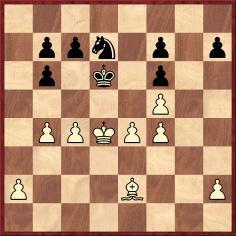
32 c5+ bxc5+ 33 bxc5+ Nxc5 34 e5+ fxe5+ 35 fxe5+ Kc6 36 Bc4 Nd7 37 Bxf7 Nf8 38 Be8+ Kb6 39 e6 c5+ 40 Ke5 Kc7 41 e7 Nd7+ 42 Bxd7 Kxd7 43 Kf6 Ke8 and ‘White mates in three’.
Whether a detailed check of local newspapers would provide many striking game-scores is an open question. The few games noted so far are rather ordinary draws, although page 9 of the Manchester Guardian, 23 January 1922 published a game against E.A. Greig and D. Joseph with an interesting rook ending:
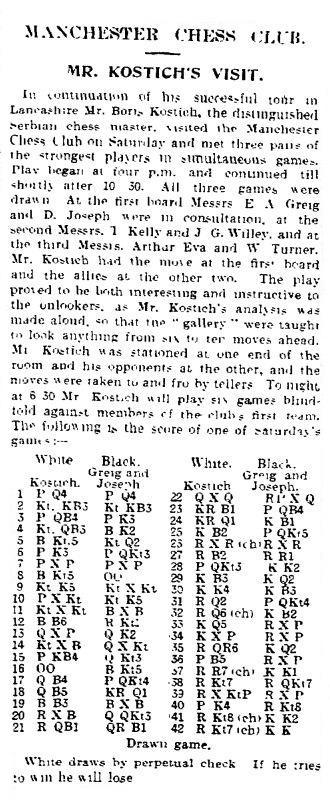
1 d4 d5 2 Nf3 Nf6 3 c4 e6 4 Nc3 Be7 5 Bg5 Nbd7 6 e3 b6 7 cxd5 exd5 8 Bb5 O-O 9 Ne5 Nxe5 10 dxe5 Ne4 11 Nxe4 Bxg5 12 Bc6 Rb8 13 Qxd5 Qe7 14 Nxg5 Qxg5 15 f4 Qg6 16 O-O Bg4 17 Qc4 b5 18 Qc5 Rfd8 19 Bf3 Bxf3 20 Rxf3 Qb6 21 Rc1 Rbc8 22 Qxb6 axb6 23 Rff1 c5 24 Rfd1 Kf8 25 Kf2 b4 26 Rxd8+ Rxd8
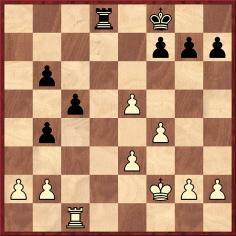
27 Rc2 Ra8 28 b3 Ke7 29 Kf3 Kd7 30 Ke4 Kc6 31 Rd2 b5 32 Rd6+ Kc7 33 Kd5 Rxa2 34 Kxc5 Rxg2 35 Ra6 Kd7 36 f5 Rxh2 37 Ra7+ Ke8 38 Rb7 Rb2 39 Rxb5 Rxb3 40 e4 Rb1 41 Rb8+ Ke7 42 Rb7+ Ke8 Drawn.
(8568)
A detail from the Carlsbad, 1911 group photograph (Wiener Schachzeitung, September-October 1911, pages 304-305):
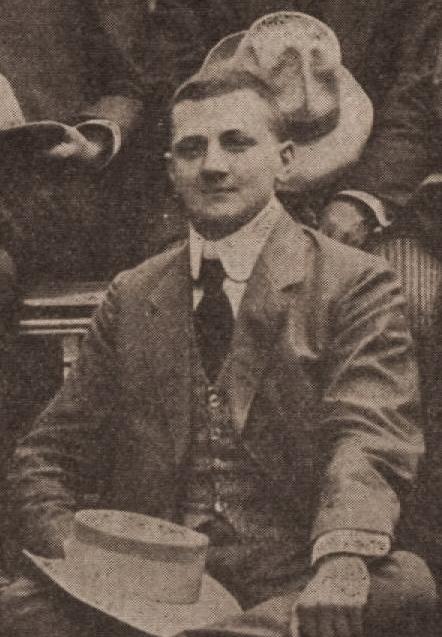
Boris Kostić
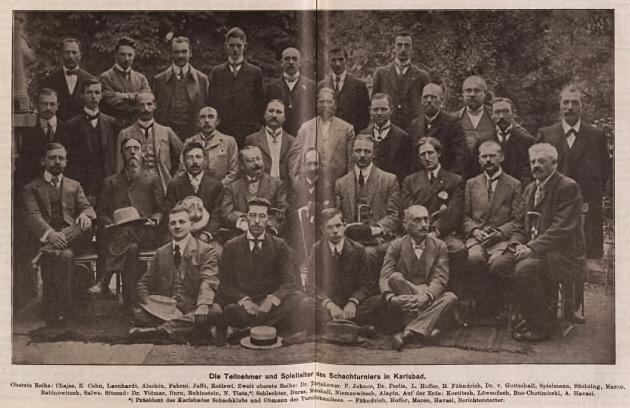
(8574)
Wanted: further details regarding a short loss by Kostić in 1924 to A. Read in a simultaneous exhibition in Australia:
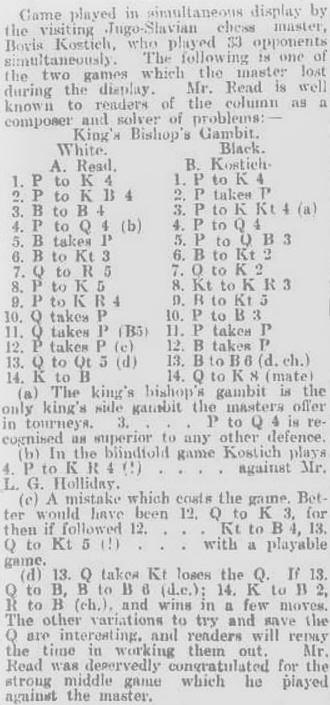
The source, provided by Graham Clayton (South Windsor, NSW, Australia), is the Adelaide Chronicle, 31 May 1924, page 23. The newspaper inverted the players’ names in the game heading.
B. Kostić v A. Read: 1 e4 e5 2 f4 exf4 3 Bc4 g5 4 d4 d5 5 Bxd5 c6 6 Bb3 Bg7 7 Qh5 Qe7 8 e5 Nh6
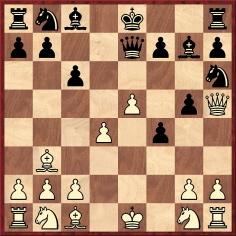
9 h4 Bg4 10 Qxg5 f6 11 Qxf4 fxe5 12 dxe5 Bxe5 13 Qg5 Bc3+ 14 Kf1 Qe1 mate.
(8645)
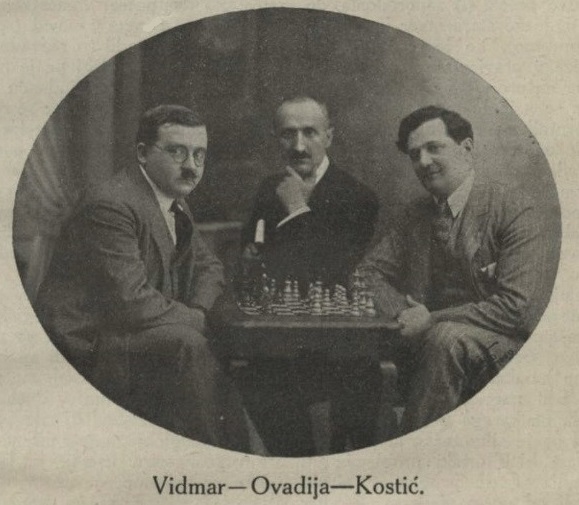
Šah, January-February 1923, page 49
(10899)
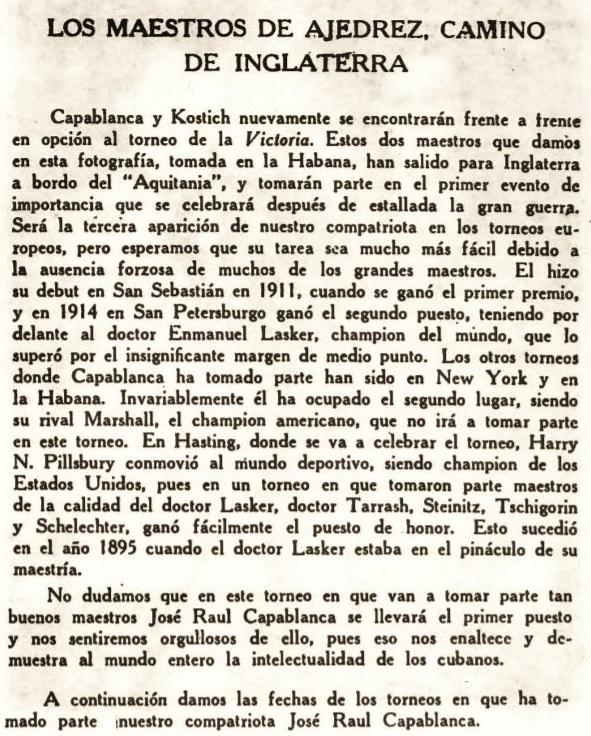
Carteles, August 1919, page 58
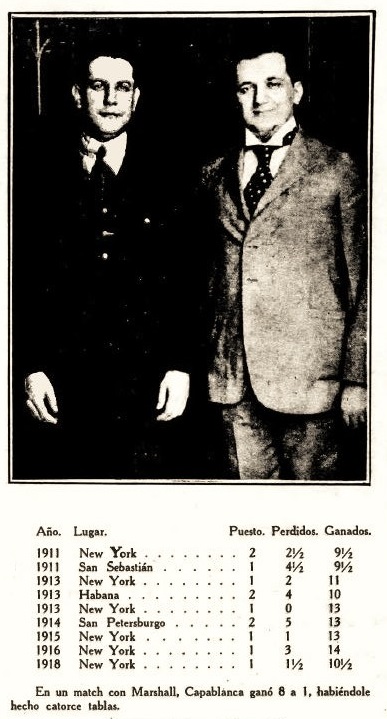
Carteles, August 1919, page 59
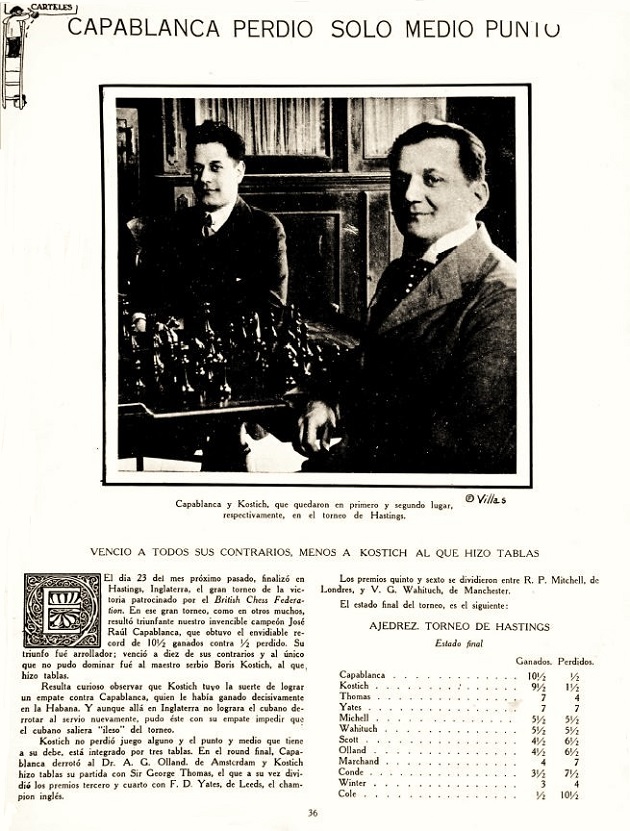
Carteles, September 1919, page 36
(11266)
Yandy Rojas Barrios notes a case of misidentification on page 154 of Bohemia, 15 November 1953, where Capablanca was said to be with ‘Alhekine’ in 1927:
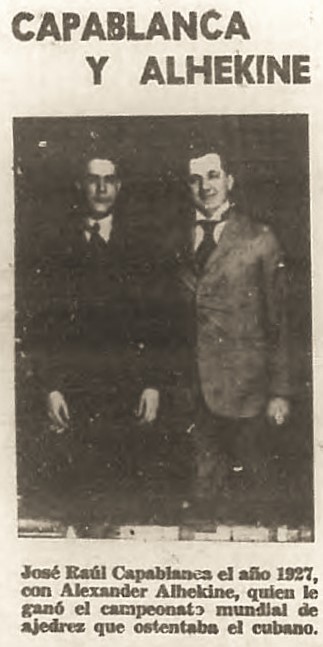
Our correspondent also refers to another photograph in C.N. 11266, from Carteles, September 1919, page 36:
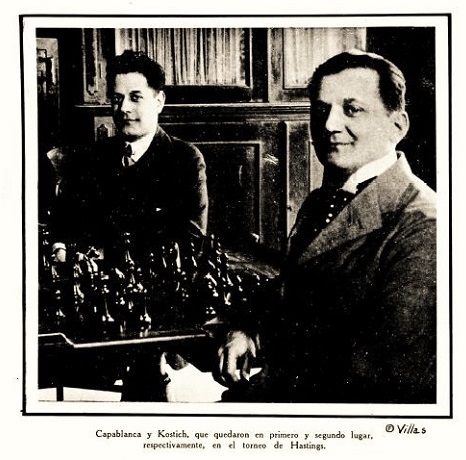
He adds that the following was on pages 36-37 of Social, April 1919:
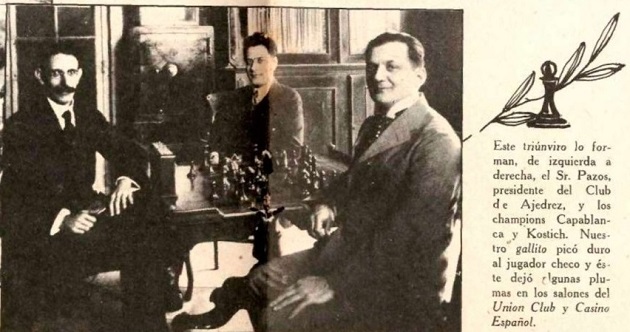
Rafael de Pazos is also in a group photograph opposite page 80 of Glorias del Tablero “Capablanca” by J.A. Gelabert (Havana, 1923):
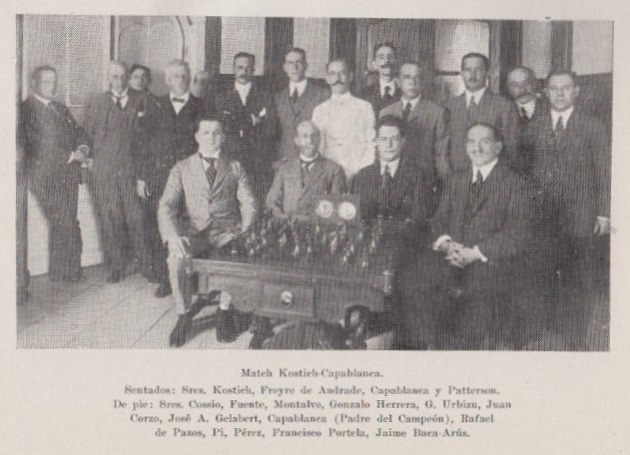
(11690)
Page 158 of our 1989 book on Capablanca quoted his words on page 10 of the New York Times, 19 February 1927:
‘... we may now be somewhat weaker than when at our best ten years ago. In the writer’s opinion, he was at his best in Havana when playing Kostić the match which Kostić lost in five straight games.’
We gave this photograph (source: Homenaje a Capablanca), showing him during the 1919 match in Havana, the onlooker being Rafael de Pazos:

From page 315 of our monograph on the Cuban:
Given Capablanca’s personal differences with Kostić he has sometimes been accused of blocking him from playing in the same event after 1919 ... They never met over the board after their match, but Capablanca was reported on page 42 of the March 1922 American Chess Bulletin as saying that he expected (wrongly as it turned out) Kostić to be a participant in the London tournament of that year. On the other hand, one piece of documentary evidence has been found to support the allegation of blocking. Writing from Havana to Mieses on 28 June 1928, Capablanca stated with regard to the forthcoming Berlin tournament: ‘... if you can raise the amount offered me from 1500 gold marks to two thousand gold marks I shall be glad to play. I must, however, make one condition and that is that Kostić shall not play’. (Source: The Russell Collection, Item 1689).
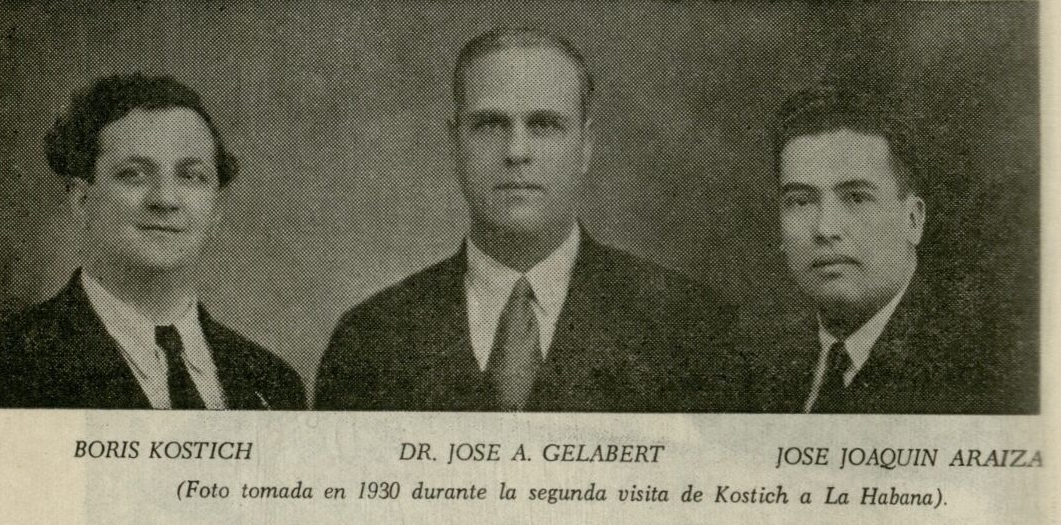
This picture was published at the start of an article by José A. Gelabert, ‘Recuerdos del Match Capablanca vs. Kostich’, on pages 72-76 of Ajedrez, December 1963. See page 94 of our book on Capablanca.
(11609)
From pages 177-178 of the South African Chessplayer, May 1954, in an article entitled ‘Greetings to South Africa!’ by Max Euwe (C.N. 11671):
‘Five years ago I met Kostić in Belgrade and played a funny game with him. Each of us in turn mentioned a country where he had been, and a point was scored when the other had not been there. The game consisted in discovering the “weak spots” of the other. I started with Trinidad, he answered Singapore. The score remained 0-0 for a long time. Then I scored: Guatemala; he answered New Zealand. I found out that Kostić had not been in Central America, and he discovered I had not been to Australia, China or Japan. The score went to 4:4, and 7:7. Africa had not been mentioned so far. When my Central American trumps were exhausted, Kostić started on Rhodesia, Kenya, Angola. Then I resigned. I had to – I knew how many countries in Africa I had never visited.’
(11685)
Page 4 of the sports section of the Salt Lake Tribune, 5 November 1922 gave Kostić v Zollner:
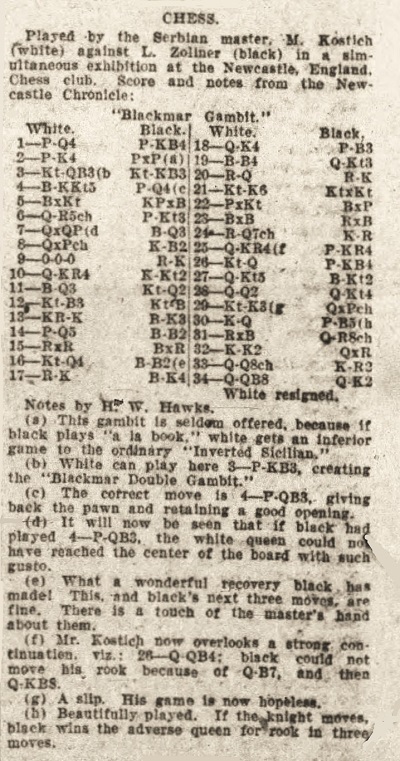
1 d4 f5 2 e4 fxe4 3 Nc3 Nf6 4 Bg5 d5 5 Bxf6 exf6 6 Qh5+ g6 7 Qxd5 Bd6 8 Qxe4+ Kf7 9 O-O-O Re8 10 Qh4 Kg7 11 Bd3 Nd7 12 Nf3 Nf8 13 Rhe1 Be6 14 d5 Bf7 15 Rxe8 Bxe8 16 Nd4 Bf7 17 Re1 Be5 18 Qe4 c6 19 Bc4 Qb6 20 Rd1 Re8
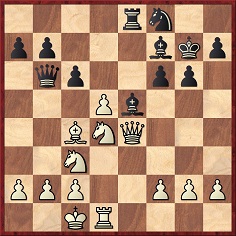
21 Ne6+ Nxe6 22 dxe6 Bxe6 23 Bxe6 Rxe6 24 Rd7+ Kh8 25 Qh4 h5 26 Nd1 f5 27 Qg5 Bg7 28 Qd2 Qb5 29 Ne3 Qxb2+ 30 Kd1 f4 31 Rxg7 Qa1+ 32 Ke2 Qxg7 33 Qd8+ Kh7 34 Qc8 Qe7 35 White resigns.
Details are sought from any Newcastle chess columns of the time.
(11298)
From page 10 of the Evening Chronicle (Newcastle), 24 March 1922:
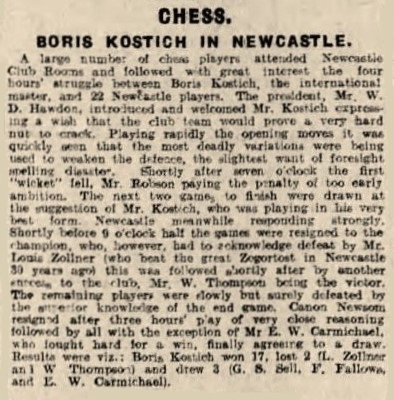
Earlier in the month it had been announced that the exhibition would take place on 22 March 1922.
Zollner’s victory over ‘Zogortost’, i.e. Zukertort, was reported on page 8 of the Newcastle Weekly Chronicle, 6 December 1884.
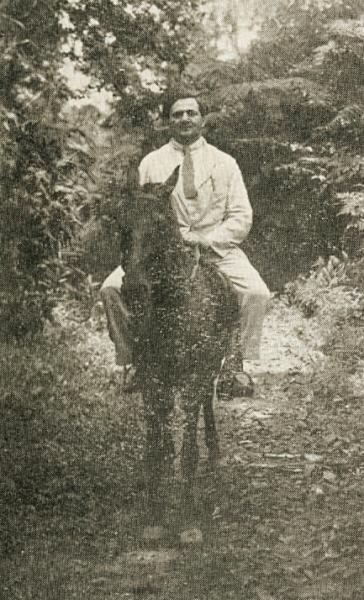
The above picture of Boris Kostić is in the plate section of a monograph on him, Ambasador Šaha by D. Bućan, P. Trifunović and A. Božić (Belgrade, 1966).
From page 43 of the February 1950 Chess Review:
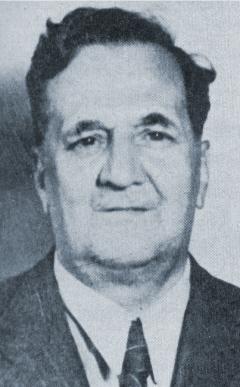
From Ben R. Foster’s chess column on page b7 of the St Louis Globe-Democrat, 18 July 1915:
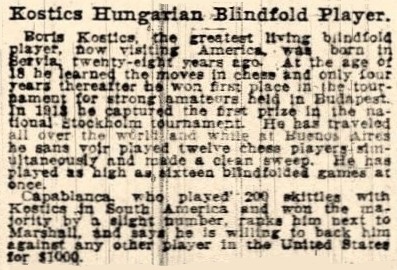
Statements by and about Kostić require particular care. What is known about the ‘200 skittles’ claim?
(12121)
Olimpiu G. Urcan provides this photograph from an unnumbered page of Fray Mocho, 28 August 1914:
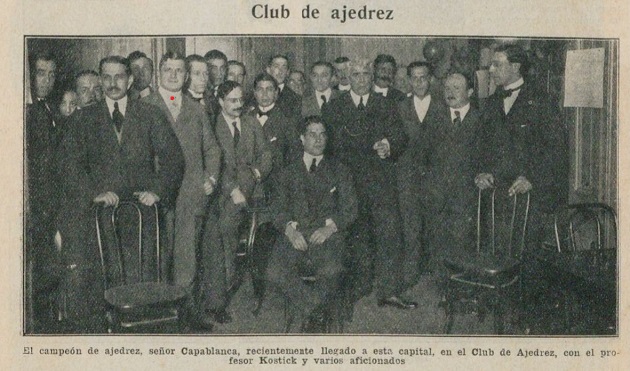
A red dot marks Kostić.
Can a better copy of the photograph be found?
(12122)
From Where Did They Live?
Kostić, B.: Prizesse Jelena-Pl. 11, Vrsac, Yugoslavia (Ranneforths Schach-Kalender, 1930, page 70).
To the Archives
for other feature articles.
Copyright Edward Winter. All rights reserved.